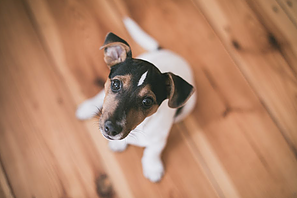Using a travel kennel for your brand new puppy will prove invaluable. The puppy will look at the crate as a bed area which will aid in housetraining. The crate will also provide a safe place where your puppy will be unable to eat or chew unwanted items. When using treats for training, each puppy will vary. Some puppies will be happy to work for puppy food, while others may need something special such as Cheerios or a very smelly, rich treat such as freeze dried liver or hotdogs. Rich treats should be the size of a pencil eraser.
You may be able to split meals into 4 portions and use these portions for training purposes. Steps to help your puppy adjust to the crate: This should be started as soon as the puppy comes home.
1. Choose a quiet place for the crate.
(Remember this will be like your puppy’s bedroom). Having a crate in your bedroom will help you hear the puppy in the middle of the night if a bathroom break is necessary.
- Keep the crate small enough for the puppy to only sleep in.
- Keep food and water out of the kennel.
- Try a soft blanket, towel, or bed but watch carefully for any signs of chewing, and remove items to prevent the puppy from swallowing anything that would need to be surgically removed.
- Have a chew toy or interactive toy which the puppy can not destroy such as a nylabone or kong.
- Some people have had success placing something warm in the crate for the puppy to snuggle up to. Be very careful since all puppies can chew aggressively.
2. Teaching your puppy
Quiet in the kennel can begin the first day you bring the puppy home.
- Make sure your puppy has urinated and defecated before going in the crate.
- Introduce the crate by tossing treats in the crate and allowing the puppy to get the treat and come back out. There is no need to praise the puppy for coming out of the kennel. Continue this process until the puppy stops coming out of the kennel and waits for more treats. This is the time to sprinkle treats over the floor of the kennel and shut the door.
- While your puppy is eating the treats, step out of sight. If you can count to ten and the puppy is quiet, stuff a treat in the door, open the door, and walk away. Let your puppy stay in the kennel if sleeping.
- After a five – ten minute break, place your puppy in the kennel, close the door, and step out of sight. Wait 10 seconds, before rewarding a quiet puppy and opening the door. Keep this process up by steadily increasing the quiet time by 10 second increments before letting the puppy out. As long as the puppy is quiet with the door shut, keep giving rewards after the lengthened time.
- If your puppy starts howling or whining in the kennel, bump the kennel and say “Quiet”. As soon as the puppy stops vocalizing, poke a treat through the door, and open the door.
- Five minutes later, put the puppy back in the kennel and wait for the count of 10. If the puppy starts howling at any time, bump the kennel and say Quiet, then start counting to 10. Keep repeating the bump and Quiet until the puppy is quiet and you can count to 10. Give a treat and open the door.
- You will repeat this process until your puppy will be quiet for 1 minute. Most puppies will fall asleep by this time. Let them sleep.
- This training session should happen three times an hour.
- Never reward a puppy that is climbing on the door or whining.
3. Eventually your puppy will need to sleep in their kennel.
All puppies will cry for a time when they realize they are alone.
- You can help your puppy adjust to their bed area by placing them in the kennel whenever they get sleepy or scheduling regular time outs for naps.
- Have your puppy get used to being on their own. Do not carry them wherever you go, or hold them on your lap while awake and keep them out of your bed.

